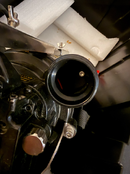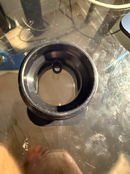A review of the Poseidon Mk6 and Seven Rebreathers………
I recently had the opportunity to buy two Poseidon rebreathers, a MK6 and the Seven. Having never dove either I was interested to see the units up close after an interesting encounter with a Poseidon rep. I was very curious about performance.
Early on Poseidon was marketing the product as “like having 2 rebreathers in one”, an Incredibly silly thing to say, hopefully the marketing team that came up with that is on the unemployment line. Poseidon has since toned it down and the website does a decent job of explaining a “rebreather” however the site claims that Tech units are manual and Recreational units are automatic. Again not a very good or accurate thing to say.
Moving on we all know Poseidon to make some of the best high performance regulators in existence, The first stage they’re selling today is arguably to most failure proof in the business. Poseidon built its reputation on these regulators, I still dive them today. Poseidon’s other products have never been in huge demand here in the states (the largest and most important market in the world).
Poseidon has other rebreather projects in development and is actively looking to expand its commercial/military footprint.
Here are my thoughts and opinions on the unit:
DISCLOSURE: I have one dive on the unit, in 20 feet of water in the East River, NYC.
Pros:
To be fair:
The unit does exactly what Poseidon says it will do. They completely re-thought and redesigned the approach to rebreather diving and they deserve credit for that. They want to invent a “recreational” rebreather market, all previous attempts have failed (Lungfish although a very cool unit and dare I say the Explorer….LOL), Poseidon thinks it can do better. I hope they succeed.
Final thoughts:
1) Seems MK6 was Beta for the Seven, the Seven if I had to bet, is Beta for something else. With all of this tech I do think that Poseidon is working on some very cool things (they actually are), we will see if its ever implemented, they certainly have the ability to produce something groundbreaking but financial viability is a huge obstacle…..as it is with all things diving.
2) The most frustrating part of this breather is the way everything is put together in the physical sense. The “layout” of the breather is very busy, diving wrecks with fishing line and nets could be problematic especially without the cowling or cover.
4) The idea of a recreational rebreather is the subject of debate, in my opinion for good reason. While “dumbing down” the complexities of a rebreather appears to make sense in the short term I’m not convinced that its smart long term. What I think the Seven does do is define a tangible path to tech diving in rebreather form.
I recently had the opportunity to buy two Poseidon rebreathers, a MK6 and the Seven. Having never dove either I was interested to see the units up close after an interesting encounter with a Poseidon rep. I was very curious about performance.
Early on Poseidon was marketing the product as “like having 2 rebreathers in one”, an Incredibly silly thing to say, hopefully the marketing team that came up with that is on the unemployment line. Poseidon has since toned it down and the website does a decent job of explaining a “rebreather” however the site claims that Tech units are manual and Recreational units are automatic. Again not a very good or accurate thing to say.
Moving on we all know Poseidon to make some of the best high performance regulators in existence, The first stage they’re selling today is arguably to most failure proof in the business. Poseidon built its reputation on these regulators, I still dive them today. Poseidon’s other products have never been in huge demand here in the states (the largest and most important market in the world).
Poseidon has other rebreather projects in development and is actively looking to expand its commercial/military footprint.
Here are my thoughts and opinions on the unit:
DISCLOSURE: I have one dive on the unit, in 20 feet of water in the East River, NYC.
Pros:
- The tech is cool, no doubt.
- It breathes well and with OTS lungs it should.
- The BOV/ADV is cool too, a little finicky but works very well, super easy one handed operation in any type of clove or mitten.
- Trims well in the water, its fully automatic and its fun to dive, I thoroughly enjoyed the East River.
- It is 100% automatic, but this is also a negative.
- It's injection molded plastic, while this helps keep costs down and with scale even more so it is by no means a robust unit.
- It's a sloppy unit, it's not tidy. Cables pop straight out of the unit up high with no protection (MK6) with the Seven protection is better.
- The way the wing and plate fit on the unit is cumbersome (MK6) and the quick release system on my Seven is more trouble than its worth.
- The scrubber is replaced from the bottom and the SS screws used fit into the aluminum “tube” isn’t well thought out. Corrosion can be seen on both units, saltwater will accelerate this process.
- The dil and 02 connections on the unit can be damaged due to the location of both, side by side on the highest point on the unit.
- I can’t recall ever having see a unit with so many failure points. Most of these failure points are static and unlikely to fail but geeez this unit loves its o-rings.
- The paddle is ridiculous. The sock needed to secure the paddle to your forearm is a necessity but its sort of like taking the short bus to school, no one wants to be that person.
- It is 100% dependent on technology without a laptop you are DOA. That likely means a separate dedicated laptop.
- The diver has no ability to override the pre-dive or even dive if something is a miss.
- Cost: DGX (Dive Gear Express) is the cheapest I found online and its $11,700 with 2 solid state sensors, the M28 computer and BMCLs, other sites approach 17,000USD for the same configuration. Basic 120 foot limited units are around 7,000 and up. Everything Poseidon is expensive and upgrades and parts don’t disappoint in that regard. The prices for these units fluctuate wildly online.
- Everything is proprietary and while this is important from a financial standpoint (guaranteed revenue down the road) it is also frustrating for anyone with experience not to mention “forced factory” service.
To be fair:
The unit does exactly what Poseidon says it will do. They completely re-thought and redesigned the approach to rebreather diving and they deserve credit for that. They want to invent a “recreational” rebreather market, all previous attempts have failed (Lungfish although a very cool unit and dare I say the Explorer….LOL), Poseidon thinks it can do better. I hope they succeed.
Final thoughts:
1) Seems MK6 was Beta for the Seven, the Seven if I had to bet, is Beta for something else. With all of this tech I do think that Poseidon is working on some very cool things (they actually are), we will see if its ever implemented, they certainly have the ability to produce something groundbreaking but financial viability is a huge obstacle…..as it is with all things diving.
2) The most frustrating part of this breather is the way everything is put together in the physical sense. The “layout” of the breather is very busy, diving wrecks with fishing line and nets could be problematic especially without the cowling or cover.
4) The idea of a recreational rebreather is the subject of debate, in my opinion for good reason. While “dumbing down” the complexities of a rebreather appears to make sense in the short term I’m not convinced that its smart long term. What I think the Seven does do is define a tangible path to tech diving in rebreather form.





